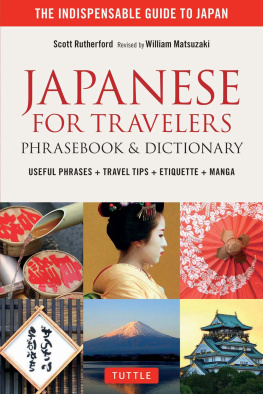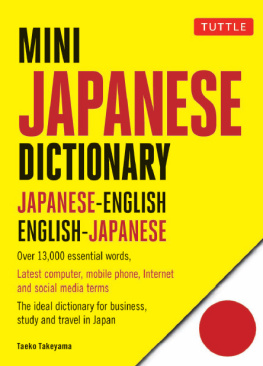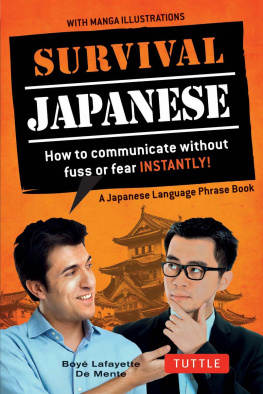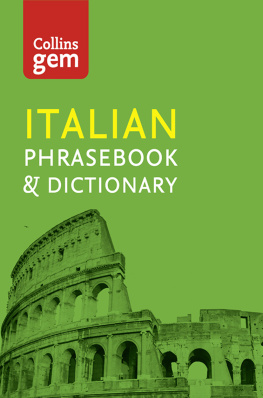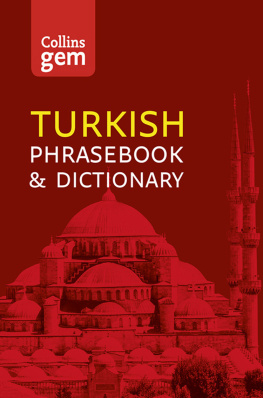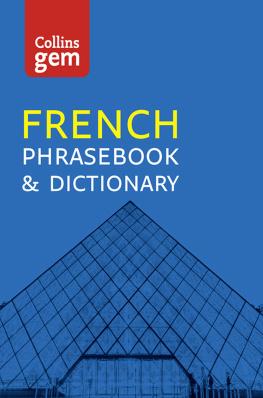ABOUT TUTTLE
Books to Span the East and West
Our core mission at Tuttle Publishing is to create books which bring people together one page at a time. Tuttle was founded in 1832 in the small New England town of Rutland, Vermont (USA). Our fundamental values remain as strong today as they were thento publish best-in-class books informing the English-speaking world about the countries and peoples of Asia. The world has become a smaller place today and Asias economic, cultural and political influence has expanded, yet the need for meaningful dialogue and information about this diverse region has never been greater. Since 1948, Tuttle has been a leader in publishing books on the cultures, arts, cuisines, languages and literatures of Asia. Our authors and photographers have won numerous awards and Tuttle has published thousands of books on subjects ranging from martial arts to paper crafts. We welcome you to explore the wealth of information available on Asia at www.tuttlepublishing.com.
CHAPTER 1
Speaking Japanese
While there is no quick way to become fluent in Japanese, this book aims to cover some of the most frequently-used (and essential) phrases for travelers to aid them while traveling around Japan. The language is easier to speak rather than to write its grammar and syntax is not particularly complex.
Challenges instead lie in the form of trying to decipher its written form, which uses hiragana and katakana two phonetic alphabetsas well as 2,000 Chinese characters, or kanji . There are also cases, especially in advertising, when Roman letters appear.
An added challenge is also the deeply embedded cultural and social codes of the Japanese language, which need years to unravel and understand. Within a group, the ideal form of communication is that which is sparse and ambiguous. Messages are conveyed through verbal fuzziness, contextual clarity, and implication. This semi-verbal mode of communication is called ishin denshin , or telepathic communication, which may seem jarringly different from the directness preferred by many Westerners.
This book attempts to help readers understand the basics of these cultural and social codes and advise them on how to avoid at least some of the more common faux pas while traveling around this lovely country.
THE JAPANESE LANGUAGE
For many Japanese, their language is a cocoon that defines the group, the nation, and the race. Recognizing you as a foreigner, Japanese will often operate on the assumption that you most certainly cant understand their language, even when a foreigner speaks their language well. Some people may talk about you openly in the elevator or in stores, especially outside the major cities. Mothers have been heard telling children in restaurants to watch how the foreigner eats, especially if the foreigner is using chop-sticks. You are, you will learn quickly, a thing of curiosity, especially outside of Tokyo and Osaka.
On the other hand, being a curiosity can have its advantages. Whatever mistake or gaffe you make, youre an outsider and a foreigner, and your mistakes are generally dismissed on that basis. Youre not Japanese, after all.
Here are some terms related to Japanese language and grammar:
| WORD | GRAMMAR | DIALECT | HIRAGANA |
| tango | bunp | hgen | hiragana |
| SENTENCE | MEANING | QUESTION | KATAKANA |
| bun | imi | shitsumon | katakana |
| PRONUNCIATION | ACCENT | FOREIGN LANGUAGE | CHINESE CHARACTER |
| hatsuon | akusento | gaikokugo | kanji |
| VERTICAL WRITING | HORIZONTAL WRITING | CHARACTER, LETTER | ROMAN LETTERS |
| tategaki | yokogaki | ji, moji | Rmaji |
JAPANESE | ENGLISH | CONVERSATION | WORD, LANGUAGE |
nihon-go | ei-go | kaiwa | kotoba |
JAPANESE SOUNDS
Japanese sounds must be pronounced with precision, especially in vowel pronunciation, to be understood by native Japanese speakers.
Vowels
In short, each Japanese vowel has a single sound, as spoken in the following words:
a as in father
e as in egg
i as in sushi
o as in oat
u as in rude
Sometimes, Japanese vowels are pronounced in two beats instead of one, for e.g., the word sji , or cleaning, ,which would be sooji . This book follows standard convention by using macrons (lines) over all double vowels except i , where the double i sound is represented as ii . It is important to be aware of this nuance of pronunciation, as the length of a vowel can change the meaning of a word completely. For example, hod means sidewalk, but hd means news report.
In regular Japanese conversation, the i and u sounds are often not heard at all. For example, the name Matsushita becomes Matsushta , and kusuri , meaning medicine, becomes ksuri. De-emphasis of i and u is especially common after the sh and k sounds.
Consonants
Japanese consonants are generally similar to English ones, but there are some important differences.
F The Japanese ear doesnt distinguish between the English f and h sounds. (On some maps of Japan rendered into English by Japanese speakers, Mt. Fuji may be written as Mt. Huji.)
The Japanese f is not a strong f sound, but is halfway between the English f and h , like an f sound in which the upper teeth do not meet the lower lip, and air is forced out through narrowed lips.
G Always g , as in gate. Often softened into ng , as in sing.
R The Japanese r hovers somewhere between the English r and l . As with the English l , the tongue is placed on the ridge behind the upper teeth, but with a lighter touch.
Like vowels, consonants are sometimes pronounced in two beats. You pronounce the double consonants by holding your breath for one beat right before the double consonant. For example, katta would be pronounced, ka- (pause) -ta . Again, this is a crucial distinction, because a words meaning can utterly change as the result of just a single doubled sound.
Doubling is especially common for t , p , and k . This book expresses doubled consonants as double letters: tt , pp , kk , etc.
Unlike English, in which every multisyllabic word stresses a particular syllable, Japanese does not stress syllables at all. For instance, although the Japanese word for banana is very similar to the English, the pronunciation is considerably different. The Japanese word is pronounced ba-na-na , with each a sounding like the a in father, each syllable having equal intensity. While stress is not important, however, proper pitch can change the unspoken message and mood.
Japanese language books commonly explain that the subject of a sentence is marked by wa , or in certain cases, ga . This is not, in fact, always the case. But, for our minimal needs, well simplify life by designating wa- and ga- marked words as subjects. Wa and ga are called particles and they connect words together, similar to prepositions in English.
Mearii wa (kaerimashita).
Mary (went home).
Note that there is no difference between singular and plural subjects in Japanese. Like much in the language, they are inferred from context.
THE SENTENCE SUBJECT OR TOPIC
Unlike in English, the subject or focus of the sentence in Japanese is often unspoken, implied instead through context. In fact, using the subject sometimes overemphasizes it, flooding it with metaphorical spotlights and exclamation points. This is a pitfall for foreigners learning Japanese, who would are accustomed to adding in subjects, as they would normally do in their native language. In the examples below, the subjects I and flower are left unsaid.
Next page
